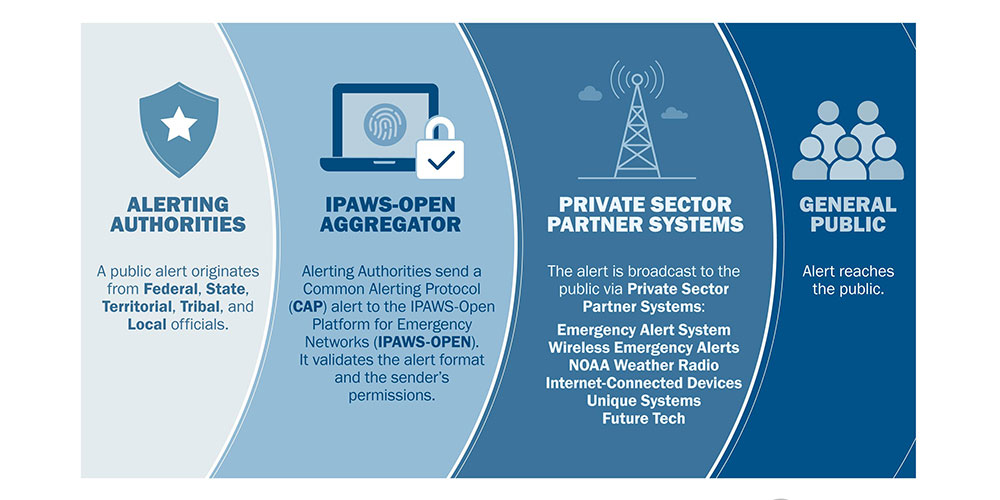The historical record has shown that natural disasters, human-caused incidents, and technological emergencies across the U.S. are increasing in frequency, intensity, and complexity. These disasters are causing devastating results in terms of loss of life, destruction of public infrastructure and personal property, environmental degradation, and impacts on the daily life of the public at large.
University and college communities depend on public safety officials to provide emergency notifications when threats and hazards pose an immediate danger to their health, safety, and well-being. In response, emergency management officials have invested resources in professionalizing their emergency response approach by implementing new strategies, techniques, and technologies to provide timely, actionable, specific, and instructional emergency information to the public during an emergency.
One powerful program available to local emergency management officials is the Integrated Public Alert and Warning System (IPAWS), developed by the Federal Emergency Management Agency (FEMA) as a modernized national system for local alerting. FEMA’s IPAWS program gives federal, state, local, tribal and territorial governments, and public sector organizations (such as universities and colleges) the ability to send emergency alerts simultaneously through multiple communication pathways.
One communication pathway, in particular, the Wireless Emergency Alerts (WEA) System, originates short, text-like emergency messages that are broadcast from cell towers to WEA-capable mobile devices (including all smartphones) during an emergency. WEAs are geo-targeted messages designed to get your attention with a unique sound and vibration to motivate life-saving actions and outcomes.
There have been numerous real-world success stories across the country of local public safety officials utilizing IPAWS, and in particular, WEA, to save lives during all-hazard emergencies. According to the Federal Communications Commission (FCC), WEA alerts have been used over 62,000 times to notify the public regarding missing children (AMBER Alerts); dangerous weather, such as wildfires, hurricanes, tornadoes, and severe storms; the COVID-19 pandemic; curfews; hazardous materials incidents; and more.
7 Reasons Colleges and Universities Would Benefit from Using IPAWS
Since the creation of the IPAWS program in 2006, 1,600 public sector agencies have been authorized to leverage IPAWS for all-hazards alerting, and more than 100 agencies are in the process of becoming authorized. However, there are currently only a handful of public universities and colleges approved to send IPAWS alerts to their campus jurisdictions.
For decades, universities and colleges have experienced natural and human-caused disasters leading the U.S. Congress to pass legislation focusing on addressing campus security, emergency notification, and crime reporting. The Clery Act and Higher Education Opportunity Act both require universities and colleges receiving federal funding to implement appropriate policies, procedures, and strategies to ensure campus safety and security.
Much like city and county municipalities, universities and colleges in the U.S. often cover large geographic areas, have a complex and dispersed nature of governance, are autonomous yet geographically integrated within the surrounding community, have transient campus populations, and operate complex enterprises in addition to their academic programs.
Such enterprises include hospitals, research and development facilities, performing arts venues, athletic complexes, agriculture centers, residential complexes, food services, and transportation systems. These critical ventures generate enormous profit and prestige, and if impacted, could greatly disrupt service delivery and the day-to-day business operations on campus.
The IPAWS program, and specifically the WEA program, is a powerful tool that greatly increases a university or college’s emergency response capabilities to alert and warn the campus population during an emergency. The benefits of the WEA program to campus public safety officials are as follows:
- Provides recipients critical life-saving instructions quickly.
- Recipients with WEA-capable phones are automatically opted-in to the WEA program. Alert students, faculty, staff, and visitors on campus without registering phone numbers.
- Messages are broadcast from area cell towers to WEA-capable mobile phones within a defined geographic location. Every WEA-capable phone within range receives the message.
- WEA messages hit 100% of the targeted area with no more than 1/10 of a mile (528 feet) overshoot.
- The WEA system is not affected by local network congestion that occurs during emergencies.
- Messages can be sent in both English and Spanish.
- WEA messages may include embedded content such as a hyperlinked URL, phone number, picture or map.
Most universities and colleges have implemented some form of facility-based, outdoor/wide area, and/or personal notification system (or a network of systems) to alert and warn their campus populations. The IPAWS-WEA program provides campus emergency managers another robust, redundant, and resilient emergency notification system to leverage during an emergency.
Public universities and colleges interested in becoming an IPAWS alerting authority should first consult with their state IPAWS representative, typically found within the state Emergency Management Agency. If initial approval is provided, the university or college can apply directly with FEMA-IPAWS by following four easy steps:
- Complete IPAWS Web-Based Training
- Select IPAWS Compatible Software
- Apply for a Memorandum of Agreement with FEMA
- Apply for Public Alerting Permissions
Here’s the IPAWS Program Planning Toolkit. It includes a link to sign up for IPAWS.
Gil Zavlodaver is the Director of Professional Services for Alertus Technologies, an emergency mass notification solutions provider. In his role, Gil oversees a department that helps customers develop and enhance their emergency management programs using customized service offerings and resources.







